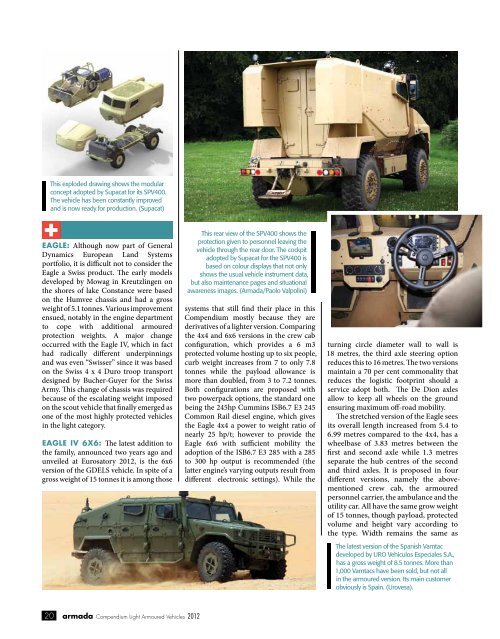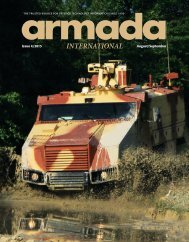Oct 2012 Compendium 1 - Armada
Oct 2012 Compendium 1 - Armada
Oct 2012 Compendium 1 - Armada
Create successful ePaper yourself
Turn your PDF publications into a flip-book with our unique Google optimized e-Paper software.
This exploded drawing shows the modular<br />
concept adopted by Supacat for its SPV400.<br />
The vehicle has been constantly improved<br />
and is now ready for production. (Supacat)<br />
EAGlE: Although now part of General<br />
Dynamics European Land Systems<br />
portfolio, it is difficult not to consider the<br />
Eagle a Swiss product. The early models<br />
developed by Mowag in Kreutzlingen on<br />
the shores of lake Constance were based<br />
on the Humvee chassis and had a gross<br />
weight of 5.1 tonnes. Various improvement<br />
ensued, notably in the engine department<br />
to cope with additional armoured<br />
protection weights. A major change<br />
occurred with the Eagle IV, which in fact<br />
had radically different underpinnings<br />
and was even “Swisser” since it was based<br />
on the Swiss 4 x 4 Duro troop transport<br />
designed by Bucher-Guyer for the Swiss<br />
Army. This change of chassis was required<br />
because of the escalating weight imposed<br />
on the scout vehicle that finally emerged as<br />
one of the most highly protected vehicles<br />
in the light category.<br />
EAGlE IV 6x6: The latest addition to<br />
the family, announced two years ago and<br />
unveiled at Eurosatory <strong>2012</strong>, is the 6x6<br />
version of the GDELS vehicle. In spite of a<br />
gross weight of 15 tonnes it is among those<br />
20 armada <strong>Compendium</strong> Light Armoured Vehicles <strong>2012</strong><br />
This rear view of the SPV400 shows the<br />
protection given to personnel leaving the<br />
vehicle through the rear door. The cockpit<br />
adopted by Supacat for the SPV400 is<br />
based on colour displays that not only<br />
shows the usual vehicle instrument data,<br />
but also maintenance pages and situational<br />
awareness images. (<strong>Armada</strong>/Paolo Valpolini)<br />
systems that still find their place in this<br />
<strong>Compendium</strong> mostly because they are<br />
derivatives of a lighter version. Comparing<br />
the 4x4 and 6x6 versions in the crew cab<br />
configuration, which provides a 6 m3<br />
protected volume hosting up to six people,<br />
curb weight increases from 7 to only 7.8<br />
tonnes while the payload allowance is<br />
more than doubled, from 3 to 7.2 tonnes.<br />
Both configurations are proposed with<br />
two powerpack options, the standard one<br />
being the 245hp Cummins ISB6.7 E3 245<br />
Common Rail diesel engine, which gives<br />
the Eagle 4x4 a power to weight ratio of<br />
nearly 25 hp/t; however to provide the<br />
Eagle 6x6 with sufficient mobility the<br />
adoption of the ISB6.7 E3 285 with a 285<br />
to 300 hp output is recommended (the<br />
latter engine’s varying outputs result from<br />
different electronic settings). While the<br />
turning circle diameter wall to wall is<br />
18 metres, the third axle steering option<br />
reduces this to 16 metres. The two versions<br />
maintain a 70 per cent commonality that<br />
reduces the logistic footprint should a<br />
service adopt both. The De Dion axles<br />
allow to keep all wheels on the ground<br />
ensuring maximum off-road mobility.<br />
The stretched version of the Eagle sees<br />
its overall length increased from 5.4 to<br />
6.99 metres compared to the 4x4, has a<br />
wheelbase of 3.83 metres between the<br />
first and second axle while 1.3 metres<br />
separate the hub centres of the second<br />
and third axles. It is proposed in four<br />
different versions, namely the abovementioned<br />
crew cab, the armoured<br />
personnel carrier, the ambulance and the<br />
utility car. All have the same grow weight<br />
of 15 tonnes, though payload, protected<br />
volume and height vary according to<br />
the type. Width remains the same as<br />
The latest version of the Spanish Vamtac<br />
developed by URO Vehículos Especiales S.A.,<br />
has a gross weight of 8.5 tonnes. More than<br />
1,000 Vamtacs have been sold, but not all<br />
in the armoured version. Its main customer<br />
obviously is Spain. (Urovesa).



